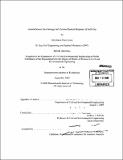Ground source heat storage and thermo-physical response of soft clay
Author(s)
Saxe, Shoshanna Dawn
DownloadFull printable version (16.29Mb)
Other Contributors
Massachusetts Institute of Technology. Dept. of Civil and Environmental Engineering.
Advisor
Andrew J. Whittle.
Terms of use
Metadata
Show full item recordAbstract
Ground source heat storage can condition buildings with reduced consumption of fossil fuels, an important issue in modem building design. However, seasonal heat storage can cause soil temperature fluctuations and possibly deformation of soft clays. This thesis evaluates the thermo-mechanical response of soft clays to seasonal heat storage and associated temperature fluctuations. A literature review reveals that, in normally consolidated to lightly overconsolidated clays, increases in soil temperature can lead to significant plastic strains and a reduction in soil strength. This behavior can be modeled through constitutive formulations that include thermal strain within the elasto-plastic framework of the well-known Modified Cam-Clay Model. The current research uses the MCC Picard (1994) model to study the ground response to a buried heat exchange pipe. The spacing of the pipe was found to govern the effectiveness of ground heat storage. With only one pipe in semi-infinite soil, heat transfer to the ground dissipates quickly and thermal-mechanical interaction is negligible; however, seasonal heat storage is not possible. Closely spaced heat pipes would permit effective seasonal heat storage, but could undergo significant thermally induced consolidation deformations.
Description
Thesis (S.M.)--Massachusetts Institute of Technology, Dept. of Civil and Environmental Engineering, 2009. Cataloged from PDF version of thesis. Includes bibliographical references (p. 137-141).
Date issued
2009Department
Massachusetts Institute of Technology. Department of Civil and Environmental EngineeringPublisher
Massachusetts Institute of Technology
Keywords
Civil and Environmental Engineering.